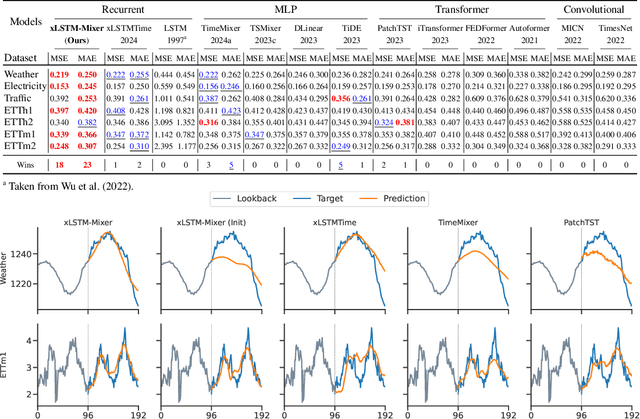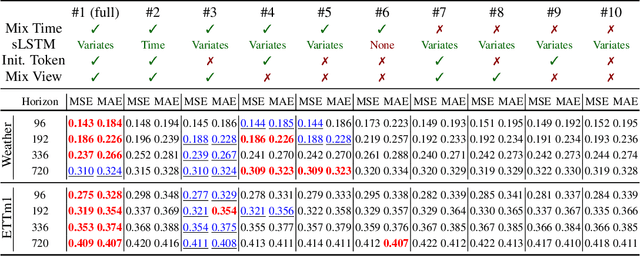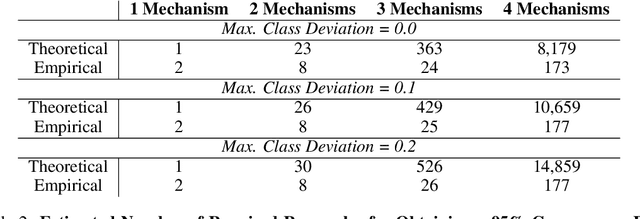Devendra Singh Dhami
TU Darmstadt
Scaling Probabilistic Circuits via Data Partitioning
Mar 11, 2025Abstract:Probabilistic circuits (PCs) enable us to learn joint distributions over a set of random variables and to perform various probabilistic queries in a tractable fashion. Though the tractability property allows PCs to scale beyond non-tractable models such as Bayesian Networks, scaling training and inference of PCs to larger, real-world datasets remains challenging. To remedy the situation, we show how PCs can be learned across multiple machines by recursively partitioning a distributed dataset, thereby unveiling a deep connection between PCs and federated learning (FL). This leads to federated circuits (FCs) -- a novel and flexible federated learning (FL) framework that (1) allows one to scale PCs on distributed learning environments (2) train PCs faster and (3) unifies for the first time horizontal, vertical, and hybrid FL in one framework by re-framing FL as a density estimation problem over distributed datasets. We demonstrate FC's capability to scale PCs on various large-scale datasets. Also, we show FC's versatility in handling horizontal, vertical, and hybrid FL within a unified framework on multiple classification tasks.
Probabilistic Mission Design in Neuro-Symbolic Systems
Dec 25, 2024



Abstract:Advanced Air Mobility (AAM) is a growing field that demands accurate modeling of legal concepts and restrictions in navigating intelligent vehicles. In addition, any implementation of AAM needs to face the challenges posed by inherently dynamic and uncertain human-inhabited spaces robustly. Nevertheless, the employment of Unmanned Aircraft Systems (UAS) beyond visual line of sight (BVLOS) is an endearing task that promises to enhance significantly today's logistics and emergency response capabilities. To tackle these challenges, we present a probabilistic and neuro-symbolic architecture to encode legal frameworks and expert knowledge over uncertain spatial relations and noisy perception in an interpretable and adaptable fashion. More specifically, we demonstrate Probabilistic Mission Design (ProMis), a system architecture that links geospatial and sensory data with declarative, Hybrid Probabilistic Logic Programs (HPLP) to reason over the agent's state space and its legality. As a result, ProMis generates Probabilistic Mission Landscapes (PML), which quantify the agent's belief that a set of mission conditions is satisfied across its navigation space. Extending prior work on ProMis' reasoning capabilities and computational characteristics, we show its integration with potent machine learning models such as Large Language Models (LLM) and Transformer-based vision models. Hence, our experiments underpin the application of ProMis with multi-modal input data and how our method applies to many important AAM scenarios.
StaR Maps: Unveiling Uncertainty in Geospatial Relations
Dec 24, 2024Abstract:The growing complexity of intelligent transportation systems and their applications in public spaces has increased the demand for expressive and versatile knowledge representation. While various mapping efforts have achieved widespread coverage, including detailed annotation of features with semantic labels, it is essential to understand their inherent uncertainties, which are commonly underrepresented by the respective geographic information systems. Hence, it is critical to develop a representation that combines a statistical, probabilistic perspective with the relational nature of geospatial data. Further, such a representation should facilitate an honest view of the data's accuracy and provide an environment for high-level reasoning to obtain novel insights from task-dependent queries. Our work addresses this gap in two ways. First, we present Statistical Relational Maps (StaR Maps) as a representation of uncertain, semantic map data. Second, we demonstrate efficient computation of StaR Maps to scale the approach to wide urban spaces. Through experiments on real-world, crowd-sourced data, we underpin the application and utility of StaR Maps in terms of representing uncertain knowledge and reasoning for complex geospatial information.
The Constitutional Filter
Dec 24, 2024Abstract:Predictions in environments where a mix of legal policies, physical limitations, and operational preferences impacts an agent's motion are inherently difficult. Since Neuro-Symbolic systems allow for differentiable information flow between deep learning and symbolic building blocks, they present a promising avenue for expressing such high-level constraints. While prior work has demonstrated how to establish novel planning setups, e.g., in advanced aerial mobility tasks, their application in prediction tasks has been underdeveloped. We present the Constitutional Filter (CoFi), a novel filter architecture leveraging a Neuro-Symbolic representation of an agent's rules, i.e., its constitution, to (i) improve filter accuracy, (ii) leverage expert knowledge, (iii) incorporate deep learning architectures, and (iv) account for uncertainties in the environments through probabilistic spatial relations. CoFi follows a general, recursive Bayesian estimation setting, making it compatible with a vast landscape of estimation techniques such as Particle Filters. To underpin the advantages of CoFi, we validate its performance on real-world marine data from the Automatic Identification System and official Electronic Navigational Charts.
Hybrid Many-Objective Optimization in Probabilistic Mission Design for Compliant and Effective UAV Routing
Dec 24, 2024Abstract:Advanced Aerial Mobility encompasses many outstanding applications that promise to revolutionize modern logistics and pave the way for various public services and industry uses. However, throughout its history, the development of such systems has been impeded by the complexity of legal restrictions and physical constraints. While airspaces are often tightly shaped by various legal requirements, Unmanned Aerial Vehicles (UAV) must simultaneously consider, among others, energy demands, signal quality, and noise pollution. In this work, we address this challenge by presenting a novel architecture that integrates methods of Probabilistic Mission Design (ProMis) and Many-Objective Optimization for UAV routing. Hereby, our framework is able to comply with legal requirements under uncertainty while producing effective paths that minimize various physical costs a UAV needs to consider when traversing human-inhabited spaces. To this end, we combine hybrid probabilistic first-order logic for spatial reasoning with mixed deterministic-stochastic route optimization, incorporating physical objectives such as energy consumption and radio interference with a logical, probabilistic model of legal requirements. We demonstrate the versatility and advantages of our system in a large-scale empirical evaluation over real-world, crowd-sourced data from a map extract from the city of Paris, France, showing how a network of effective and compliant paths can be formed.
Answer Set Networks: Casting Answer Set Programming into Deep Learning
Dec 19, 2024



Abstract:Although Answer Set Programming (ASP) allows constraining neural-symbolic (NeSy) systems, its employment is hindered by the prohibitive costs of computing stable models and the CPU-bound nature of state-of-the-art solvers. To this end, we propose Answer Set Networks (ASN), a NeSy solver. Based on Graph Neural Networks (GNN), ASNs are a scalable approach to ASP-based Deep Probabilistic Logic Programming (DPPL). Specifically, we show how to translate ASPs into ASNs and demonstrate how ASNs can efficiently solve the encoded problem by leveraging GPU's batching and parallelization capabilities. Our experimental evaluations demonstrate that ASNs outperform state-of-the-art CPU-bound NeSy systems on multiple tasks. Simultaneously, we make the following two contributions based on the strengths of ASNs. Namely, we are the first to show the finetuning of Large Language Models (LLM) with DPPLs, employing ASNs to guide the training with logic. Further, we show the "constitutional navigation" of drones, i.e., encoding public aviation laws in an ASN for routing Unmanned Aerial Vehicles in uncertain environments.
Graph Neural Networks Need Cluster-Normalize-Activate Modules
Dec 05, 2024Abstract:Graph Neural Networks (GNNs) are non-Euclidean deep learning models for graph-structured data. Despite their successful and diverse applications, oversmoothing prohibits deep architectures due to node features converging to a single fixed point. This severely limits their potential to solve complex tasks. To counteract this tendency, we propose a plug-and-play module consisting of three steps: Cluster-Normalize-Activate (CNA). By applying CNA modules, GNNs search and form super nodes in each layer, which are normalized and activated individually. We demonstrate in node classification and property prediction tasks that CNA significantly improves the accuracy over the state-of-the-art. Particularly, CNA reaches 94.18% and 95.75% accuracy on Cora and CiteSeer, respectively. It further benefits GNNs in regression tasks as well, reducing the mean squared error compared to all baselines. At the same time, GNNs with CNA require substantially fewer learnable parameters than competing architectures.
xLSTM-Mixer: Multivariate Time Series Forecasting by Mixing via Scalar Memories
Oct 23, 2024



Abstract:Time series data is prevalent across numerous fields, necessitating the development of robust and accurate forecasting models. Capturing patterns both within and between temporal and multivariate components is crucial for reliable predictions. We introduce xLSTM-Mixer, a model designed to effectively integrate temporal sequences, joint time-variate information, and multiple perspectives for robust forecasting. Our approach begins with a linear forecast shared across variates, which is then refined by xLSTM blocks. These blocks serve as key elements for modeling the complex dynamics of challenging time series data. xLSTM-Mixer ultimately reconciles two distinct views to produce the final forecast. Our extensive evaluations demonstrate xLSTM-Mixer's superior long-term forecasting performance compared to recent state-of-the-art methods. A thorough model analysis provides further insights into its key components and confirms its robustness and effectiveness. This work contributes to the resurgence of recurrent models in time series forecasting.
Systems with Switching Causal Relations: A Meta-Causal Perspective
Oct 16, 2024



Abstract:Most work on causality in machine learning assumes that causal relationships are driven by a constant underlying process. However, the flexibility of agents' actions or tipping points in the environmental process can change the qualitative dynamics of the system. As a result, new causal relationships may emerge, while existing ones change or disappear, resulting in an altered causal graph. To analyze these qualitative changes on the causal graph, we propose the concept of meta-causal states, which groups classical causal models into clusters based on equivalent qualitative behavior and consolidates specific mechanism parameterizations. We demonstrate how meta-causal states can be inferred from observed agent behavior, and discuss potential methods for disentangling these states from unlabeled data. Finally, we direct our analysis towards the application of a dynamical system, showing that meta-causal states can also emerge from inherent system dynamics, and thus constitute more than a context-dependent framework in which mechanisms emerge only as a result of external factors.
BlendRL: A Framework for Merging Symbolic and Neural Policy Learning
Oct 15, 2024



Abstract:Humans can leverage both symbolic reasoning and intuitive reactions. In contrast, reinforcement learning policies are typically encoded in either opaque systems like neural networks or symbolic systems that rely on predefined symbols and rules. This disjointed approach severely limits the agents' capabilities, as they often lack either the flexible low-level reaction characteristic of neural agents or the interpretable reasoning of symbolic agents. To overcome this challenge, we introduce BlendRL, a neuro-symbolic RL framework that harmoniously integrates both paradigms within RL agents that use mixtures of both logic and neural policies. We empirically demonstrate that BlendRL agents outperform both neural and symbolic baselines in standard Atari environments, and showcase their robustness to environmental changes. Additionally, we analyze the interaction between neural and symbolic policies, illustrating how their hybrid use helps agents overcome each other's limitations.
 Add to Chrome
Add to Chrome Add to Firefox
Add to Firefox Add to Edge
Add to Edge